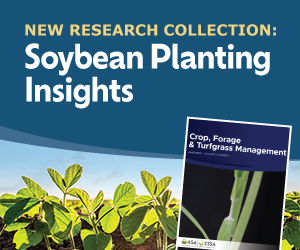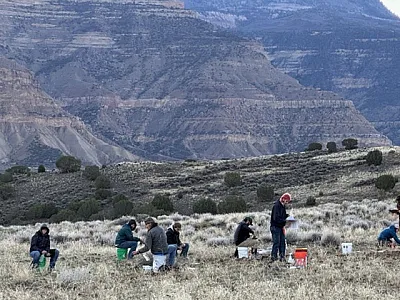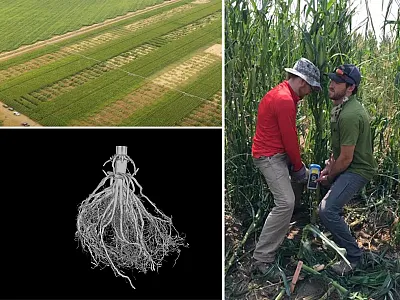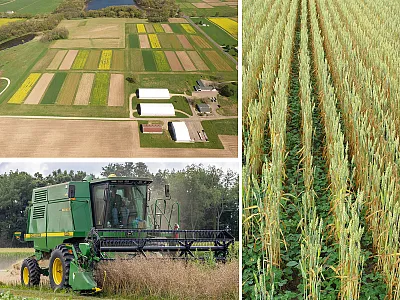Scrutinizing SLAKES
Testing the Limits of the Soil Aggregate App
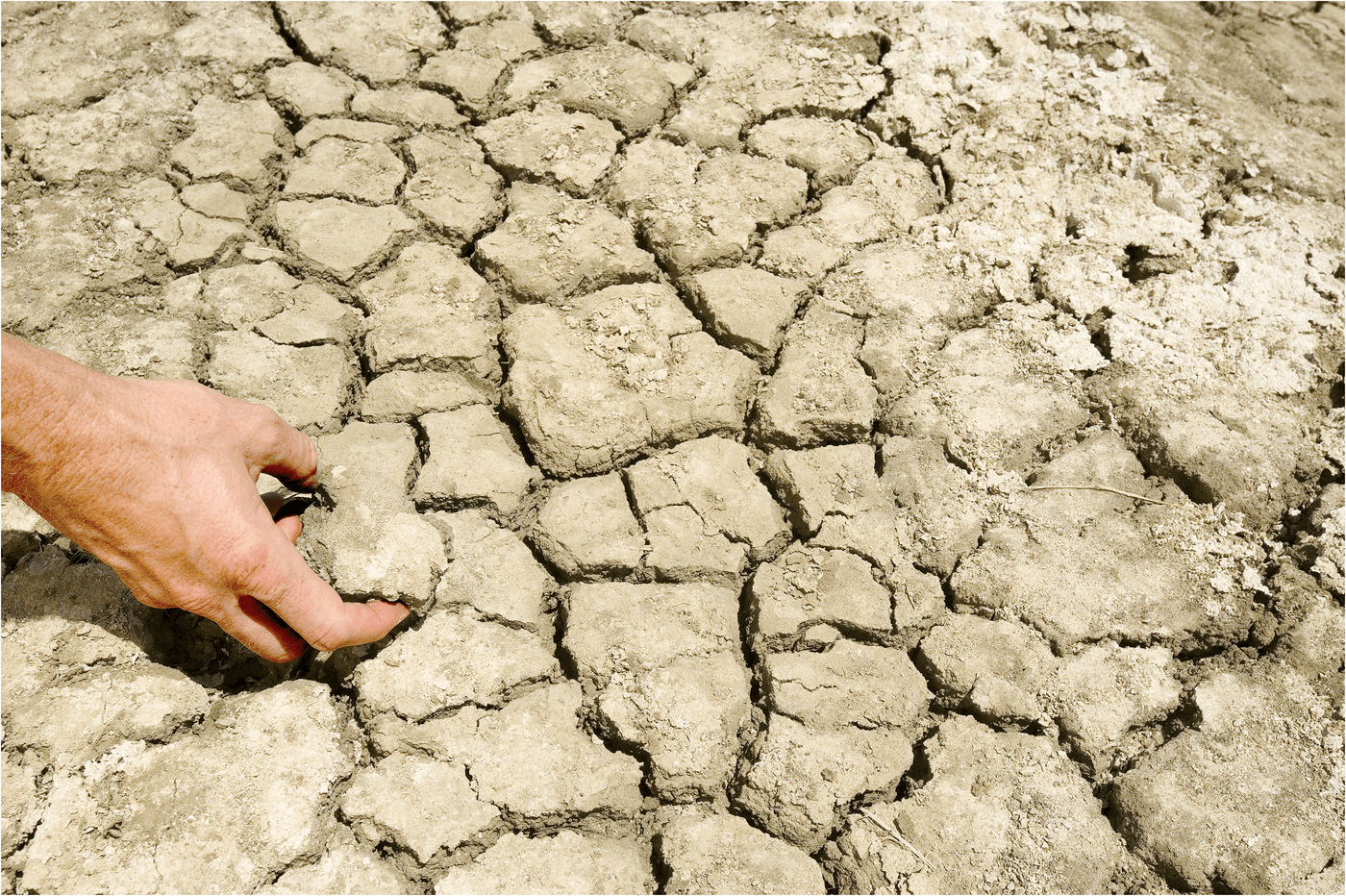
The feasibility of the SLAKES app, which provides an accurate, inexpensive, and fast method to determine soil aggregate stability, has been assessed for coarser- grained soil aggregates, opening opportunities to expand it for use in more soil textures.
Soil, an unconsolidated assortment of organic carbon and rock fragments (sediment grains), is imperative to agriculture. It sustains plant and animal life, regulates water flow, filters and buffers pollutants, cycles nutrients, and provides physical stability. Soil particles adhere together to form aggregates that contribute to soil structure and stability, and are integral components in how soils respond to disturbances, like heavy rain events, and topsoil degradation.
Soil conservation explores different practices, such as tillage, manuring, and crop rotation, to maintain soil health, but these approaches are not uniformly positive in maintaining soil aggregate stability. Soil managers often use this soil property to identify regions that are underperforming and modify practices to bring a field back into a healthy setting, but this approach is more complicated than it appears.
Researchers have worked for decades to find an accurate, reliable, affordable, and efficient way to quantify soil aggregate stability. Factors that commonly affect this soil characteristic include aggregate size, as well as moisture and clay content.
Measuring soil aggregate stability begins by breaking apart the aggregate through various means, including differential swelling, raindrop impact, physiochemical dispersion, and slaking (the compression of entrapped air during fast wetting). As the aggregate degrades, various methods have been used to measure stability, such as wet sieving, ultrasonic dispersion, X‐ray imaging, spectroscopic techniques, water drop impact tests, and dry sieving. All of these approaches require specialized instruments, time, labor, and money. The results are heavily dependent on the purpose of taking the measurement and how the person running the sample interprets the data.
For more than half a century, the preferred method to measure aggregate stability has focused on determining mean weight diameter after wet sieving a soil aggregate. While the method is simple and intuitive, it is cumbersome, requiring special equipment and the time for post processing, including oven‐drying and weighing of many size fractions. Multiple samples are required to obtain an estimate, increasing the complexity. This approach is also hindered by a matter of standardization.
Introducing the SLAKES Method
Mario Fajardo, a research affiliate at the Precision Agriculture Laboratory of the University of Sydney, needed a fast and reliable method to determine soil aggregate stability while conducting a larger study in New South Wales, a section of Australia the size of France. The techniques available were not feasible with the number of people on the project and the time available. Inspired by suggestions of his supervisors and colleagues (Alex McBratney and Damien Field from the University of Sydney) Fajardo made a profound leap forward in this effort and published his new approach—the SLAKES method. The results of the initial study were published in the journal Soil and Tillage Research in 2016.
SLAKES has proven to be deceptively simple, yet effective. Fajardo set up an experiment based on the Emerson dispersion test. He positioned digital cameras around a petri dish to capture images of the soil aggregate as it crumbled and changed shape when suspended in water.
“Soil is a mixture of a million things, and they are acting with the environment,” Fajardo says. “It is very hard in soil science to find a simple formula for a behavior, but we were able to model an entire behavior with a simple function [that] was quick and elegant, and it worked for different types of soil.”
Fajardo used images that captured changes in the aggregate’s area over time to develop an algorithm to describe the kinetics of the slaking process. SLAKES provides a simple, objective, and effective way to tackle this long‐standing need in agriculture. In addition, the numerous images offer a new way to visualize the dynamic disaggregation process.
Fajardo tested the SLAKES over a range of ecological conditions in New South Wales. The study compared results from paired native and agricultural samples across two transects—a north–south transect (900 km) from Queensland to Victoria and an east–west transect (930 km) from Coffs Harbour to Wanaaring. The soils evaluated in the study spanned a variety of soil textures (mean 26% clay).
Fajardo developed an empirical model based on the data that he gathered along the two transects. He found that disaggregation began with an initial rupture as trapped air escaped the aggregate structure. This typically occurs within the first 20 seconds after exposure to water. He fit the remaining disaggregation data into three coefficients. The maximum slaking potential was set as ‘coefficient a.’ The initial slaking time was linked to ‘coefficient b.’ The growth rate of aggregate area was related to ‘coefficient c.’ The three coefficients were fit to the Gompertz function to define soil aggregate stability.
Fajardo and his colleagues found that the natural sites produced aggregates with greater stability. His work points to a higher concentration of organic carbon and/or other binding agents in the natural setting that acts as a natural glue holding the pieces of the soil in the aggregate structure together.
There’s an App for That
Later in 2019, Fajardo made his algorithm available as an app. This app is now maintained by the Soil Health Institute. The organization made modifications to the app—now available in its current iteration as SLAKES—to improve the user experience. The app is set to monitor the disaggregation of a soil sample in water and gather data that can be inserted into the algorithm developed by Fajardo. The app aims to make the measurement of soil aggregate stability more assessable for farmers and soil managers. Despite SLAKE’s promise, Fajardo didn’t test the results of the app against the standard methods as a comparison.
Kade Flynn, a soil scientist at the Soil Health Institute, took up the challenge and compared the results of the SLAKES app to the standard soil aggregate technique, the Cornell Wet Aggregate Stability test. The results were published in 2019 in the Soil Science Society of America Journal (https://doi.org/10.1002/saj2.20012).
Flynn’s team tested air‐dried samples obtained from till, no‐till, and grass fields from the Middle and Lower Brazos River watershed in Texas. The samples were classified in three categories of soil: (a) fine, Smectitic, thermic Udic Haplusterts (18 samples); (b) Udertic Paleustalf (one sample); and (c) Cumulic Haplustolls (three samples). The researchers found that the app output was influenced by the dynamics of disaggregation and the quality of data gathered to fit to the model.
Flynn was able to show this smartphone app is more accurate at quantifying aggregate stability than traditional lab‐based methods. The team also found that the SLAKES app differentiated the land management style more accurately than the standard techniques.
In subsequent studies, the SLAKES smartphone app has been applied to agricultural landscapes across Australia to map soil aggregate stability to identify areas where slaking is high and could lead to erosion and where slaking is reduced due to high organic carbon content in the soil. This map could potentially be used to guide management decisions.
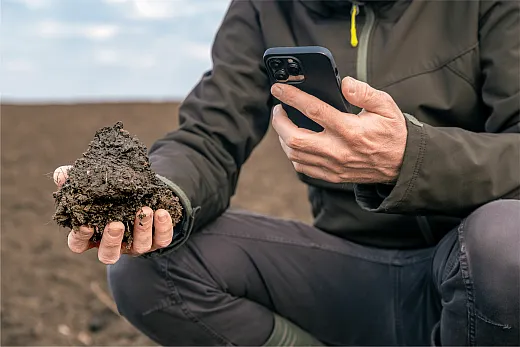
Using Soil Aggregates to Study Soil Microbiome
Mario Fajardo and Vanessa Pino recently published research in the journal Molecular Ecology about soil microbial communities, which initially prompted the development of the SLAKES app. Microbes rely on the spaces within a soil aggregate pore to survive. Understanding changes in the microbiome is critical for protecting soil functions. The researchers conducted a large‐scale, gene‐based exploration of the Australian soil microbiome using microbe community dissimilarity as a proxy to evaluate changes in the microbiome over space and time. Their study suggests microbe community dissimilarity is driven primarily by soil chemistry (e.g., pH and effective cation exchange capacity) and cycles of soil temperature. Cultivated soils had lower diversity in microbe communities, especially in rare microbes that could compromise soil function over time.
Standardizing SLAKES
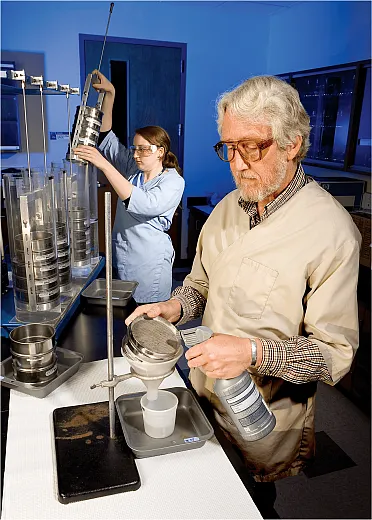
The SLAKES method has proven to be a powerful tool to evaluate fine‐textured soils, but the accuracy and reproducibility for different sediment textures remains unclear. Diana Vigah Adetsu, a Ph.D. student in the Department of Agroecology, Soil Physics and Hydropedology at Aarhus University, Denmark, expanded the study of soil texture using the SLAKES approach. Adetsu evaluated the output from SLAKES over a wide range of soil types from silty clay to sandy loam obtained from samples across Europe. The results were recently published in the Soil Science Society of America Journal (https://doi.org/10.1002/saj2.20674).
“SLAKES is an important addition to soil health managers’ toolkit,” Adetsu says. “However, we need more tests on various soil textures to understand in detail the method’s capability and applicability to different soil types.”
In this study, Adetsu and her colleagues evaluated samples collected from three long‐term experiments in Sweden (silty clay, 636 mm precipitation), Germany (silty loam, 484 mm precipitation) and Denmark (sandy loam, 953 mm precipitation). The three locations have similar mean annual temperature but varied in precipitation and soil texture.
The app’s output is influenced by the dynamics of aggregate disintegration and the quality of the fit of the data obtained by the app to the Gompertz function. Adetsu experienced problems using the automated fit for many samples. This outcome was particularly pronounced for coarse‐grained samples.
SLAKES sensitivity depends on the slaking descriptor employed. In this study, Adetsu found SI600 (a calculated value expressing the maximum slaking index at the end of the test) was the most accurate descriptor of aggregate stability. The typical coefficient used—aSK (the arithmetic mean of coefficient a for three aggregates)—was not effective in the study because of the difficulties in fitting the coefficients from the app to the Gompertz equation.
Adetsu points to the app run time, which was not long enough to capture the entire disaggregation process of the coarse‐grain soil aggregates. This deviation affected the fit to the app’s algorithm.
Adetsu also experienced varying results with moist samples. SLAKES is positioned as a field test, but the moist sediment pellets did not disaggregate in a similar manner as dried aggregates, for which the SLAKES algorithm was developed.
Overall, Adetsu’s results support SLAKES as an effective approach for silty clay and silty loam soils. Coarse sediment (sandy loam) produced the greatest deviation from the model but were also the most stable during experiments.
Adetsu offers several suggestions that could improve the app. First, she proposes giving the user the flexibility to set the sample run time in the app. She also notes the need to include Gompertz coefficients (a, b, and c) from individual aggregates to understand how the weighted final averaged coefficients were calculated from the contributing samples.
“It is important that other studies test the method especially on coarse‐textured soils over a wide range of pedometric and mechanical characteristics, which will give credence to the suitability or not of the method for these soils,” Adetsu says. “I believe this will be relevant knowledge for the community and will spur further developments needed in the app to improve flexibility, so the full potential of the method can be harnessed.”
Concluding Thoughts
Under closer scrutiny, SLAKES continues to be an effective measure of soil aggregate stability for fine‐textured soils. The app also generates useful information in a rapid and inexpensive manner that can be beneficial for a wide range of stakeholders focused on using this physical measure to assess soil health.
Further research is needed to confirm the benefit of the current app’s configuration for coarser‐grained aggregates and new approaches to modify the app to accommodate a wider range of soil textures so that accurate, reliable, and reproducible measurements can be made.
“It is a privilege to be part of something that continues to be useful, be criticized and improved, and ultimately adopted by institutions,” Fajardo says. “Developing such a simple methodology to explain a behavior was super nice. It is the result of a lot of work and a lot of luck to nail it.”
DIG DEEPER
Check out some of the research highlighted in this article.
Fajardo, M., McBratney, A. B., Field, D. J., & Minasny, B. (2016). Soil slaking assessment using image recognition. Soil and Tillage Research, 163, 119–129. https://doi.org/10.1016/j.still.2016.05.018
Flynn, K.D., Bagnall, D.K., & Morgan, C.L.S. (2020). Evaluation of SLAKES, a smartphone application for quantifying aggregate stability, in high‐clay soils. Soil Science Society of America Journal, 84, 345–353. https://doi.org/10.1002/saj2.20012
Adetsu, D. V., Arthur, E., Fu, Y., Cornelis, W., & Lamandé, M. (2024). Exploratory assessment of the SLAKES method to characterize aggregate stability across diverse soil types. Soil Science Society of America Journal, 88, 1086–1099. https://doi.org/10.1002/saj2.20674
Text © . The authors. CC BY-NC-ND 4.0. Except where otherwise noted, images are subject to copyright. Any reuse without express permission from the copyright owner is prohibited.




